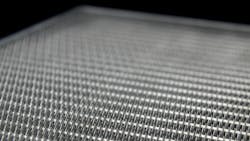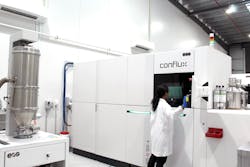How Conflux Technology is Pursuing Net-Zero Goals and F1 Engineering in Aerospace
Key Highlights
- Conflux Technology aims to reduce emissions and support the aerospace sector's goals of net-zero carbon emissions by 2050.
- The company is integrating F1 engineering principles in aircraft development and manufacturing to enhance sustainability and efficiency.
- Additive manufacturing enables complex, monolithic designs that require new handling and cleanliness protocols for maintenance.
The Aviation Pros Podcast recently spoke with Dijon Valentim, engineering services manager at Conflux Technology, about helping propel the aerospace sector closer to its net-zero goal with innovations in heat exchange technology and the use of F1 engineering principles to develop and produce aircraft.
Valentim noted, “A lot of the work that we're doing in the aviation space is linked to these new technologies—hydrogen fuel cells, electric aircraft—because those are essentially the early adopters in the aviation space.”
“We’re a new technology that is attractive to those programs, and that's where there's a nice intersection of the two technologies and coming in as demonstrators at lower technology readiness levels and maturing our product through to higher technology readiness levels,” he added.
Why are sustainability and the net-zero goal important to Conflux Technology?
On the significance of the goal of net-zero carbon emissions by 2050 and sustainability to Conflux Technology, Valentim shared, “I think that’s one of our core reasons for coming into existence. Fundamentally, heat exchangers are everywhere and most machines and devices have them. And if we really want to make an impact, we need to scale those energy efficient solutions.”
He continued, “So, the more prevalent we can put our make technology and the less emissions and less energy they consume, that's really going to help contribute to the bigger picture of scaling performance while reducing emissions. It means a lot to us because behind the scenes, we can make a big impact.”
Dijon noted how Conflux is approaching these goals, stating, “With all the environmental legislation, and as we continue into the climate crisis, what can we do with the same or less to get better performance?”
“And fundamentally, that's looking at the way heat exchangers specifically are designed and manufactured and leveraging their AM technology,” he said, “We're able to do a lot more with a very similar volume.”
How are partnerships helping Conflux innovate in the aerospace sector?
To highlight the specific projects Conflux has been undertaking in the pursuit of net-zero flight, Valentim discussed the company’s partnerships with aviation organizations, such as its collaboration with Airbus.
Valentim shared, “We're announcing it now, but we've actually been working with them for about six years. It's been a long partnership thus far, and that project is related to their ZEROe platform. It's a hydrogen fuel cell electric aircraft.”
He continued, “We've been working them on numerous projects, and we’ve delivered TRL 4-level devices with the development ongoing. And the plan there is obviously to step through TRL 5 and beyond.”
“It's taking technology providers such as ourselves, integrating those into Airbus's platform and helping them deliver against their challenges because fundamentally compared to traditional aviation platforms, they're different challenges,” said Valentim.
He added, “And by leveraging these new technologies, fundamentally, we can provide the same or similar packaging, volumes, weights, et cetera, but with improved performance.”
Valentim also mentioned the Clean Aviation Joint Undertaking (CAJU), an organization delivering one of the projects Conflux has contributed to.
He said, “One of the projects being delivered under CAJU is called TheMa4HERA. That stands for Thermal Management for Hybrid Electric Regional Aircraft. So, a platform that would serve shorter journeys across Europe. Honeywell is the project lead on that. We are supporting them and that project, specifically focused on thermal management solutions.”
Valentim proceeded, “It’s working with them and about 28 other different partners providing expertise and innovation in other spaces. And we're coming together to bring the best of what we can do into a whole system and we're working through.”
“The objective of that program is to go from TRL 3 to TRL 5,” Valentim noted, “We're midway through that project, so by the end of next year, the whole platform should be a TRL 5 level, and then there's subsequent steps to continue to develop the technologies.”
Why apply Formula 1 engineering to aircraft development and manufacturing?
Valentim shared that learning about Formula 1 engineering and working for OEMs in the past that operated F1 teams has informed his recent work with Conflux Technology, which involves applying F1 engineering principles to aircraft design and manufacturing.
“The timing constraints and the expectations are very similar to aviation, but the timing is just compressed almost exponentially—very, very short lead times but little to no certification requirements,” Valentim said, “So, that's a big difference between the two.”
He added, “It's that ethos of high development, quick turnarounds, really optimizing for what we have. And then testing and validating and fine tuning as we go through the TRL levels.”
Valentim continued, “That gives you quick development loops and moves the needle. And then you combine that with the certification requirements and the rigor of the TRL levels.”
Offering an example, Valentim explained, “If I use the example of a condenser, an incumbent, traditional condenser in this type of aviation application, it's usually got a large frontal area, quite a thin device, and has the relevant pumps et cetera to drive the medium through it.”
“What you'll probably see is a revision or a new approach to that, leveraging the technology we have where we can rethink the system rather than just dropping in a replacement heat exchanger,” asserted Valentim.”
“You could also then start to make new decisions and new choices around the system as a whole and then leverage AM also in other spaces, not necessarily us with heat exchangers, but it'll create new opportunities,” he offered.
How can maintenance technicians prepare for aircraft developed with F1 engineering?
Valentim offered advice to engineers and technicians who may work on these aircraft in the future, whether at OEMs during development and manufacturing or in the repair shop at MROs once the aircraft enter into service and require maintenance.
He said, “The shapes and the way they look is going to be different. I think that the first thing that people are going to notice is, hey, this is quite different. Not necessarily in the way it interfaces, but the shape may be weird. It'll be more along the lines of monoliths.”
“You won't be getting an assembly, it'll just be a single piece item,” he elaborated, “And with that, there'll obviously be some handling requirements, some cleanliness requirements. Furthermore, as the technology becomes more validated and more prevalent out within the market, it will also start to drive changes in the systems.”
When asked if repair shops will need to train technicians in new skills or to obtain new equipment or tools to work on these aircraft, Valentim answered, “No specific equipment, but because of the nature of the AM devices, the geometries that we can achieve are completely different. So, cleanliness is absolutely something that people need to be more cognizant of.”
Valentim explained, “Fundamentally, you can cram more surface area for heat exchange in an equivalent volume. That means far more intricate designs, which means cleanliness is a major concern. So, that's something where they will be required to have more onerous levels of cleanliness control, as well as the simple fact that the devices themselves will have some different requirements.”
“For example, you would typically not necessarily go drill holes in a device and make changes like that,” he continued, “So, you could have other devices designed for drop-in replacements, depending on the interface.”
“The technology pivots then where it's a monolith, it's a single part. We need to be aware of that and be careful handling it. It's not like you can go and service a device by opening it up. It’s just a single piece,” concluded Valentim.
Valentim also commented on what excites him about applying Formula 1 engineering principles in these applications, sharing, “I think it's the novel approach and it's the first principles thinking for that F1 approach that asks, what can we do differently based on the physics of what we're working within those constraints?”
He added, “And it'll allow people to think differently. Currently, we're quite constrained in these traditional methods of doing it. We can now rethink this system at a high level and then there will be new solutions that I have no idea what they are yet, but I'm very excited to see.”
Readers can listen to the full episode of the Aviation Pros Podcast that features Dijon now.






